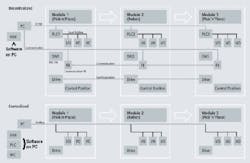QUESTION:
Weve gotten along pretty well with PLC-based machine controls. We supply machines to the contract liquid-filling industry, where we or our customers havent had to deal very much with enterprise connectivity issues until now. Were having some difficulty sorting the competing vendor arguments that 1) we should just augment our PLC controls with a PC-based HMI to obtain the needed connectivity, or 2) we need to convert entirely to PC-based control to eliminate integration and support issues. Any advice?
From August 2006 Control Design
Answers:
Use Only Big Name PC Systems
I have done numerous service calls on all types and brands of machine tool controls including Fanuc, GE/Fanuc, Control Technologies, and MDSI OpenCNC. Im qualified to rate these controls with longevity in mind, which is a concept that seems to be lacking in the articles in your magazine. Many of the controls I work on are more than 10 years old, and some have been more than 25 years old.
When I refer to PC-based control, I mean the mish-mash of several manufacturers hardware products, specifically those manufacturers that are small in size or havent proven their longevity yet.
Most, if not all, of the PC-based controls I service have obsolete, irreplaceable parts in them. These usually are DAQ or I/O boards, especially counter I/O boards designed for encoders. It seems the manufacturers often re-design these boards, and dont offer repair services for their obsolete boards. Board repair often is impossible without the schematic diagrams and part specifications on a circuit board.
Ive found that many engineers who completed PC-based installations no longer work for the company that installed the system. Often the company that installed the PC-based controls is defunct. I could make changes to the software configuration to allow newer hardware replacements, except for software Catch-22s. Sometimes the software packages are turned over to the machine owner, but its more likely the engineer keeps the packages. Whats more, the software often cant be replaced without reengineering the entire control software configuration, due to version compatibility problems. There are the compatibility issues with the OS, DirectX, PC hardware drivers, machine I/O board drivers, and the proprietary CNC software package versions. All these versions must be of certain ranges in order to make a working package. Even if I had the proprietary software, it might require an older version of Windows to run properly, and the customer seldom has the original OS discs. If they did, MS Windows 98 updates are no longer supported by Microsoft, so we couldnt get some of the old hardware drivers. There would be no way to return the system to its original state. If it were an older OS such as Windows 95 or DOS-based, that would be even worse. Those issues wont get any easier over the next 10 years.
Customers dont want a control that must be retrofitted every five to 10 years, and the machine downtime for such retrofits can be a real business-killer. However, most customers Ive dealt with dont yet know the drawbacks of PC-based controls, and I feel an obligation to tell them when the subject comes up.
There will be growing negative sentiment toward PC-based controls among the managers who buy PC-based machinery over the next 10-15 years due to service problems.
As for augmenting our PLC controls with a PC, I believe this to be a perfectly acceptable alternative. I also would point out that some PLC manufacturers make PC processors that plug-in to existing PLCs. They include integrated Ethernet ports and would make a good solution if many PC components external to the processor module arent needed.
Johnnie Alderson, president, Mainely Controls, Wayne, Me.
PLCs and PCs Can Co-Exist, But
For an already installed PLC-based system, you shouldnt need to replace everything with PC-based control. Its possible to share data with PC-based systems via OPC. We achieved just such coordination a few years ago with A-B PLC systems and about two dozen PC-based systems. The two system types coexisted happily. However, integration and support issues did require having access to two technical experts instead of just one.
Harmony aside, PC-based control has evolved beyond just the PC. With PC-based automation vendors developing more products that are real-time OS and FPGA-based, the old complaint that PC-based equals Windows-based no longer holds true.
Yes, developing control systems on Windows machines has its share of headacheslike when IT unilaterally decides to override local machine settings regarding automatic updates, and pushes through an XP SP2 update that breaks network connectivity. Such headaches are overcome by moving to real-time platforms that Windows updates cant reach and which are deterministic by design.
So, while its possible for the two types of systems to coexist, the more common question is whether PLC-based systemswith their inherent lack of performance expansionneed to be deployed at all, save for the sake of nostalgia.
Chris White, certified LabView architect, ThinkG Consulting LLC, Oceanside, Calif.
PC Controls Must Be Robust
Many people believe that having a separate PC simplifies the replacement of the PC in the event of a hardware failure. This only is true if youre using an industrial PC where you can get product continuity over a long period of time. You also should consider using a UPS on the PC to reduce the risk of files being corrupted during power failures and improper machine shutdowns. I highly recommend Microsoft Windows XP Embedded as the operating system for the PC because this version of Windows is designed with our industry in mind. Its simple to configure XPe, so that it boots from a read-only partition, which guarantees that Windows starts the same way every time. XPe also is very small in size, so it can boot from compact Flash, eliminating the need for a hard disk. The final thing you should do is restrict access to the standard Windows environment (desktop and start menu, and dont leave the machine logged in as administrator).
Once youve taken these steps to ensure you have the most robust PC setup for your machine, its a small step to add the real-time control to the PC as well. Its important to make sure that you select a real-time control system that doesnt stop in the unlikely event of a blue screen of death. It also is wise to choose a real-time control system thats 100% compatible with a PLC solution. This allows you to start with separate PLC and PC, and then change to PC-based control with little or no effort. With this approach you can have common application code shared between two different platforms, allowing you to pick and choose, depending on the size and complexity of the machine.
John Roberts, distribution sales manager, B&R Automation, Roswell, Ga.
Theres Another Option
You might want to consider Option 3a control hardware system with innate enterprise connectivity designed on standard PC-based and networking technologies. This solution will be less of a headache to implement, use, and support because the hardware already understands and uses the technologies, protocols, etc., commonly used at the enterprise level, such as IP, Ethernet, TCP, SMTP (e-mail), FTP and HTTP, and XML.
A programmable automation controller (PAC)-based system offers the durability, reliability, and control capability of a PLC. Theyre industrially hardened for plant floor use, their TCO is much lower than a PC, and they can be programmed with tools similar to ladder diagram. Some PACs offer RLL as an option for creating control logic.
PACs are very similar in the practice to PLCs, yet offer so much more. They are designed from the ground up on COTS technology, with Intel and Motorola-based processors, embedded Ethernet, serial ports, and all those protocols mentioned earlier. Expanding this set of enterprise connectivity options usually is facilitated by a simple firmware upgradein many ways future-proofing your control system. There are full-featured, dual-Ethernet, TCP/IP-enabled PACs (to get your data up to the enterprise) on the market for less than $1,000.
James Davis, senior systems engineer, Opto 22, Temecula, Calif.
PC Solution Simplifies Communications
Augmenting a traditional PLC with a PC should be quite simple at first glance. A method of communication must be established between the HMI PC and the PLC. However, finding a network and protocol that both the PLC and HMI understand can be troublesome and expensive. After the method of connection has been established, the method of data transfer also must be determined. In order for the data transfer to happen, the PLC code often must be adjusted to accept the data from the PC. There also is quite a significant increase in cost with this approach because of the extra hardware and connectivity requirements.
Converting the system to an IPC running real-time automation software or an embedded PC with Windows CE offers the ability to readily communicate between HMI software and the PLC. Even multiple PLCs become software functions on a single PC and data easily can be transmitted internally between that one PC's HMI and "soft" PLCs--in very large amounts if necessary. With the PC-based system there only is one hardware component: the PC. A common argument for keeping the PLC is that if the HMI PC fails, the PLC alone can still run the machine. Once the PLC is re-programmed to receive the data from the HMI PC, it might not be capable of running blind without the HMI PC. So if your system needs an HMI PC and needs to run PLC code, a fully software-based system is often much more powerful, less expensive and requires fewer components. Vendors of PC-based controls that provide PLC functionality might even include the programming software on every PC--eliminating the need to purchase numerous programming licenses of PLC software or have dedicated PCs to run the PLC programming software. Users of PC-based control can easily make changes directly on the machine's IPC.
PLC-based decentralized/distributed architecture versus PC-based centralized architecture. (Click image to open an enlarged PDF of the chart.)
Rob Rawlyk, Applications and Engineering Manager, Beckhoff Automation, Burnsville, Minn.
January's Problem |
Check out "The Best Of" The Answer to Your Problems, where we list all published questions and answers.
Continue Reading

Leaders relevant to this article:





